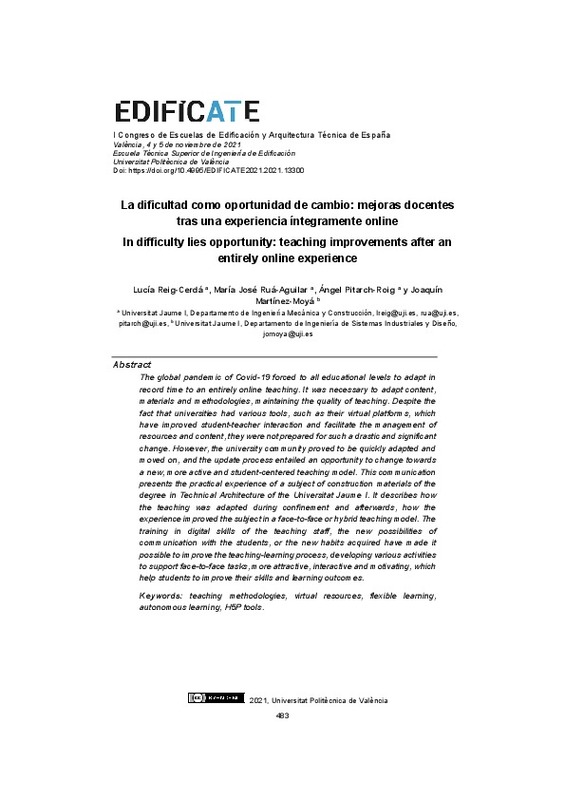JavaScript is disabled for your browser. Some features of this site may not work without it.
Buscar en RiuNet
Listar
Mi cuenta
Estadísticas
Ayuda RiuNet
Admin. UPV
La dificultad como oportunidad de cambio: mejoras docentes tras una experiencia íntegramente online
Mostrar el registro completo del ítem
Reig-Cerdá, L.; Ruá Aguilar, M.; Pitarch Roig, À.; Martínez Moya, J. (2021). La dificultad como oportunidad de cambio: mejoras docentes tras una experiencia íntegramente online. En EDIFICATE. I Congreso de Escuelas de Edificación y Arquitectura Técnica de España. Editorial Universitat Politècnica de València. 483-494. https://doi.org/10.4995/EDIFICATE2021.2021.13300
Por favor, use este identificador para citar o enlazar este ítem: http://hdl.handle.net/10251/178454
Ficheros en el ítem
Metadatos del ítem
| Título: | La dificultad como oportunidad de cambio: mejoras docentes tras una experiencia íntegramente online | |
| Otro titulo: |
|
|
| Autor: | ||
| Fecha difusión: |
|
|
| Resumen: |
[EN] The global pandemic of Covid-19 forced to all educational levels to adapt in
record time to an entirely online teaching. It was necessary to adapt content,
materials and methodologies, maintaining the quality of ...[+]
[ES] La pandemia mundial de la Covid-19 obligó a adaptar en tiempo récord una docencia íntegramente online en todos los niveles educativos. Fue necesario adaptar contenidos, materiales y metodologías, evitando perjudicar ...[+]
|
|
| Palabras clave: |
|
|
| Derechos de uso: | Reconocimiento - No comercial - Sin obra derivada (by-nc-nd) | |
| ISBN: |
|
|
| Fuente: |
|
|
| DOI: |
|
|
| Editorial: |
|
|
| Versión del editor: | http://ocs.editorial.upv.es/index.php/EDIFICATe/EDIFICATe2021/paper/view/13300 | |
| Título del congreso: |
|
|
| Lugar del congreso: |
|
|
| Fecha congreso: |
|
|
| Tipo: |
|









